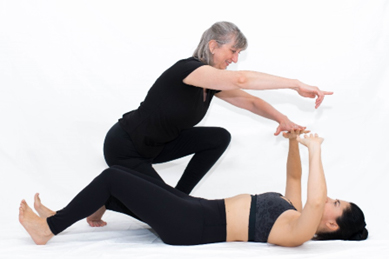
The HYPOPRESSIVE™ techniques were created in Europe in the early 1980s with the goal of helping postnatal women prevent and recover from pelvic floor dysfunctions such as incontinence and prolapse. From the outset, the objective was to develop a global approach to core health through the creation of a conditioning technique that would benefit the whole core system, and eliminate the injuries caused by detrimental pressure to the pelvic floor (as is so often the case with traditional abdominal exercises).
The term ‘HYPOpressive’ refers to a decrease or reduction in pressure. This form of exercise reduces pressure to the thoracic, abdominal, and pelvic cavities, where traditional exercises, abdominal training, gravity, as well as many of our daily activities are HYPERpressive – they increase intra-abdominal pressure. It is not to say that doing these everyday activities are bad for us, in fact most of what we do – even walking – increases this internal pressure. What we need to address is how well our bodies can manage these pressures and prevent the onset of injury/dysfunction.
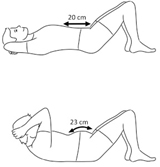
Try lying on your back, place your hands on your lower abdomen. Now cough. What happens? Does your stomach push out? Does your pelvic floor move down? Something as simple as a light cough can increase a great deal of pressure. Since you are already on your back, try a traditional abdominal crunch or abdominal exercise of your choice (not too many!). What happens? Can you feel the increase in pressure downwards, outwards, on your back, neck?
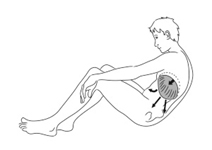
Pulling your belly button in toward your spine all day is like squeezing on a tube of toothpaste. As toothpaste will be pressed out of the hole of the tube, so too will the pressure you create attempt to push through any weak point you may have in your core. Over time, these weak points can eventually manifest themselves in any number of symptoms of a dysfunctional core.
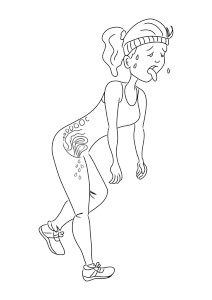
These Hyperpressive activities can prove detrimental to those with a core that is unable to manage these pressures, leaving them with one or multiple symptoms that could include incontinence, prolapse organs, abdominal hernia, vertebral hernia, and biomechanical instability. Recognizing that you are susceptible to increasing your chances of developing any of these symptoms is half the battle, and prevention should become of utmost importance. It is therefore important for us to balance all these Hyperpressive activities with one that is Hypopressive in nature.
Traditionally the emphasis on core training has been abdominal-centric, either for aesthetic appeal or to generate strength and power – building and toning these muscles through voluntary movement. Not only are these muscles being over-worked, but popular exercise programs tend not to address the conditioning of three major segments of the core — the multifidus, pelvic floor, and the diaphragm – and rarely have any purposeful effect for the other main component of our core system – the transverse abdominals.
The traditional approach to core training does not seem to recognize the core’s true required purpose and may even be considered counterproductive in our efforts to attain a more optimized and functional core. By ignoring these four important pieces (multifidus, pelvic floor, diaphragm, and transverse abdominals) and their intricate role within the core, we are hampering our ability to achieve optimal core function.
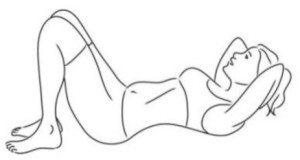
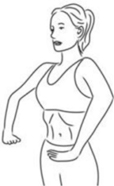
We understand that the core is fundamental to our overall health, and this complex system deserves a new means of conditioning that embraces a more global approach — one that addresses its overall function.
Although this new form of Core Exercise seems at the outset counter intuitive, Hypopressive/Low Pressure Fitness is however an effective and, most importantly, natural and balanced means of attaining true Core Function.
Hypopressive – Low Pressure Fitness addresses the whole body and its integrated relationship with the different systems. Unlike other approaches that work to correct one segment at a time, this unique program offers improvements in one’s overall health, in as little as 20 min but don’t be fooled into thinking this is a relaxing breathing technique.
The Respiratory muscles are used to help create a vacuum affect resulting in a decrease of pressure within the thoracic, abdominal, and pelvic cavities. The diaphragm acts like a plunger, influenced in its more relaxed state, it is then lengthened during the apnea and rib expansion phase, causing the vacuum.
It is after the final exhale when you end in an apnea (temporary cessation of breathing) and commence what we call a false inhale (when you mimic taking a breath without letting air in) It is this false breath in combination with the activation of the diaphragm’s antagonist muscles, serratus & inspiratory muscles that cause the automatic functional engagement of the abdominal and pelvic body while decreasing pressure. This decrease in pressure provokes a suction and elevation of the connective tissues, offering a myofascial release while decongesting the pelvic cavity. It is this synergistic, reflex co-activation of the core/postural musculature (transverse abdominals, pelvic floor muscles, multifidus, and diaphragm) that trains this integrated group of muscles to function together. Core function can be greatly improved by correcting ones breathing habits.
Hypopressive™ – Low Pressure Fitness training however is far more than just a breathing technique. If you have ever tried this technique, you know this to be true. There are specific technical patterns that have been created, each pattern has been studied to facilitate this decrease in pressure and amplify the hypopressive effects, raise the internal organs and achieve better posture.
The postural tensegrity (a word that combines ‘tension’ and ‘integrity’) developed within each pose creates a more balanced and functional body as a whole. If there is movement, pulling or pushing in one area energy is sent through the entire body and everything moves creating a global visceral, fascial, and muscular stretch. Within the poses there are specific areas of pull, lengthening, pull or axial shift forward to achieve this response and in the end, you are left with better alignment, continuity, and an overall improved carriage. When you improve one’s posture you are also helping to improve one’s breathing ability and vice-versa all of which creates a core body that can move synergistic-ally and manage the stresses of everyday living in addition to the physical activities we love.
For more information or to schedule sessions please contact
Teisa at [email protected] or
https://www.oneagorahealth.com/